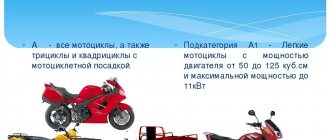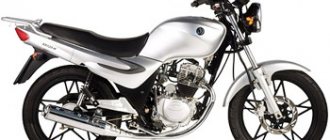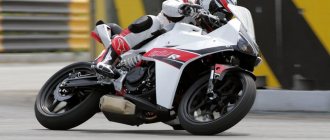This is a rather archaic road bike, which, however, deserves to be called a rarity. Despite the fact that the Yamaha XJR 400 was released in the nineties, the motorcycle is made in accordance with the typical design features for bikes of the eighties, and these features are simplicity and reliability.
The bike is perfect for both beginners and those who do not accept anything other than the old classic technology. It is unlikely that the Yamaha XJR 400 will appeal to those who are accustomed to the appearance and characteristics of modern road motorcycles. One whine of the local engine can scare off such a crowd.
Dimensions and weight
This road classic has a tank of 18 liters, and average fuel consumption per hundred kilometers varies from 5 liters to 7 liters. At the same time, the dry weight of the XJR 400 is 176 kg, the curb weight is 195 kg. The motorcycle is not suitable for people of slight build, but those with an average constitution will be quite comfortable.
Review of the Yamaha XJR 400 motorcycle
From May 8 to October 15, 2009, I drove 6,000 km. He has never let me down even once! The impression is that the device is indestructible. In the heat I was stuck in traffic jams (the air didn’t overheat), I flew into puddles in a rainstorm, I got through car washes with foam... whatever and however you want, without restrictions! Simply put, the next bike will definitely be an XJR, but already 1300. With strong bumps (speed bumps, for example), the rear shock absorbers are easily nailed all the way, especially when driving together. (I’m 85kg, the girl is 58), so drive very quietly. Doesn't eat motor oil! in 6 thousand km I added only 100 grams, and then rather to calm myself down. The gearbox is not clear, but like all pits. (neutral is difficult to find) but after adjusting the foot “to suit you” and the day of riding, you can completely adapt. The clutch block rattles through life like a bucket of bolts (these are design features), especially on a cold engine, after warming up it becomes easier, with full warming up the “uninitiated” do not notice extraneous noise, but if you put a cb400 next to it, then the XJR will clearly stand out . (apparently due to the lack of a water jacket).
In the winter I got my license and already in April I bought a MTIK 2000 (bought at a showroom) The Yamaha worked smoothly for 3 days, and then everything was FUCKED!………………. My main mistake was that I wanted to speed up the purchase process (money was burning my neck) and was led by how the motik sparkled. In 1 year I changed everything possible (started with the engine and ended with tires) and invested about 120,000 thousand rubles, despite the fact that the motorbike cost 115,000. Here is my advice to you before buying a 400: check the compression in the cylinders (10 atmospheres in all boilers ), if there is at least 2 atmospheres less, expect trouble. There are often noises in the engine, this is most likely caused by the bearing in the clutch area (a disease of all XJRs), but in principle this is not serious, because the life of a cracking bearing is longer than the life of the engine. It is very important that the tank and fuel system are clean!!! All other shortcomings are less common, and the appearance is at your discretion. The main thing is not to lose your head when buying a motorcycle and then you will be guaranteed biker happiness!!!
I had a hijz and a super truck!) I drove the truck for a year and didn’t like it!
After that, I decided to take a hijir on the guy’s advice and did not go wrong! The Motz is awesome, in every way! Well, my personal opinion! Excellent, solid and reliable Motz! Only positive memories!
And most importantly, the engine is fast, after 6.5 thousand it gets a kick, no worse than a bandit!) That's it!
Judging purely by the characteristics, the XJR 400 and the CB400 are twins, practically the same thing, but since I also had the chance to ride a Honda, I can say that they have a noticeable difference in behavior on the road. The Yamaha is bigger, heavier and somehow more imposing, or something. A kind of sofa with soft suspension. In terms of acceleration dynamics and other things, one bike is worth another. The maximum speed is 180 km/h according to the speedometer, from start to hundreds it takes about five seconds, the gearbox works well, although it is not always possible to find neutral after stopping at a traffic light the first time.
Control precision is a little lacking, sharp maneuvers are not for the XJR 400, it feels like the motorcycle responds to commands with a kind of laziness, although there are no serious complaints. The same CB400 still handles better, but the Yamaha is more convenient in terms of comfort. Even the standard seat makes me happy, it’s soft, you can’t slide on it, although mine was old, dried out, and therefore when it rained, it picked up water through the seams, after which it took a long time to dry out. But the XJR400 absorbs asphalt unevenness well. The brakes are what really pleases us on this motorcycle; three discs are solid. The bike brakes very well.
I haven’t had the opportunity to travel very far, a maximum of 500-600 km from home, but such a trip can be endured without strain. The wind, however, blows away, driving faster than 120 km/h is inconvenient - your neck gets tired, but you can install glass. I didn’t set it because I didn’t go much faster than the same 120-130 mph. The motorcycle was used 95% of the time in the city, and there is no need for wind protection. But after five or six hours behind the wheel, nothing got tired - neither my legs, nor my back, nor my arms. The tank is enough for more than 200 kilometers, if you don’t drown it. Gasoline 92. A couple of times after weird refueling, the motorcycle fired at the muffler and subjectively the traction disappeared a little, but it didn’t refuse to go.
Of the minuses, we can say about the high consumption at high speed - if anyone likes to drive, this is relevant; at a speed of 150-160, the Yamaha XJR 400 eats the tank dry in 150 kilometers. The suspension is soft - both a plus and a minus, as it is comfortable, but the sharpness of control is a little lacking. There is also not enough traction at the bottom - the engine needs to be revved up to maintain dynamics. There are no complaints about reliability, all the problems that the motorcycle had were quite natural for old equipment, so I won’t go into details.
Among the advantages, I would like to note the comfort, low cost of all services and the availability of all consumables without problems. A motorcycle is like a motorcycle, no more and no less, just a comfortable and fairly reliable four hundred. Just right for a beginner like me, or if someone just needs an inexpensive bike for every day. No worse or better than the same Seabikh, it’s just a different motorcycle, that’s all.
I drove the XJR400 '93 for 6 years. — I had no problems, I only changed consumables. In terms of acceleration dynamics, it clearly surpasses the CB400. (I raced with him three times and he didn’t beat me even once). The statement about the brakes is also true - they are clearly more effective on the XJR. SV has dropsy, smoother engine operation, less noise.
Chassis and brakes
The telescopic fork here has a fairly generous 130mm of travel, while the rear swingarm travel is 110mm. The latter, by the way, can adjust the preload, unlike the front fork. The brakes are quite good, especially for an old-school vehicle: at the rear there is a 245 mm disc and a two-piston caliper, and at the front there are a pair of 300 mm discs with four-piston calipers.
The XJR 400 frame is made of steel, which is consistent with the character of such a classic. In general, the exterior of this motorcycle is very old-fashioned and allows you to completely immerse yourself in the era of the eighties. The wheels here are cast and made very simply.
Yamaha XJR 1300 (1999 – present, RUB 150,000–450,000)
"Khizher." how much in this word for motorcyclists the times of the first wave of Japanese second-hand clothing. Those who were more experienced were hunting for the 1200 and the more modern 1300, while beginners were looking for a “four hundred”. Be that as it may, the entire Yamaha XJR family is very popular in Russia. Specifically, the XJR1300, thanks to its powerful engine, is a classic with advanced dynamic capabilities.
Engine
The donor in-line four-cylinder air-oil power unit from the Yamaha XJR 1200 was inflated by 63 cm3, which added 8 hp. With. peak power and an additional 9 Nm of peak torque. This engine is very noisy. He likes to bang his valves in vain. Often prone to non-criminal (in the early stages if in good condition) eating oil. There have been cases of engine overheating in plugged plugs. The motor is very vibration-loaded!
Transmission
The gearbox is replete with inaccuracies. A false neutral can appear at the most inopportune moment. The unit is quite noisy. Due to the relatively violent nature of the engine, it is necessary to service and replace the drive chain a little more often than on other classics. The weak point of the transmission is the spring disk, bearings and bushings in the clutch basket.
Frame and body kit
The duplex steel frame is quite monumental. He rarely suffers from falls. Just like the engine. The same cannot be said about the exhaust system “cans” sticking out to the side and the exterior elements.
Brakes
The front calipers are from the earliest YZF - R 1 - and that says it all! For such a heavy motorcycle they were quite enough. This, however, does not exclude a large number of tuning components, which will allow you to obtain a small valuable margin in deceleration dynamics.
Pendants
The front fork is definitely considered too soft by everyone who has ever ridden an XJR 1300. The same cannot be said about the rear shock absorbers, which (long live the Ohlins factory) give the motorcycle handling and a feeling of the contact patch of the rear wheel that is not typical for such big guys.
Comfort
The XJR 1300 is a pleasure to drive without stops or traffic jams. The hot and shaking engine reacts poorly to the crowd, incinerating the owner. Driving close to overheating, especially, brings serious repairs closer. Touring and light promenades with a passenger are where the XJR 1300 comes from. The heavy weight contributes to a smooth ride. The aerodynamics definitely need improvement for long trips. Luggage systems are plentiful. The XJR 1300 handles them easily. The appearance does not suffer much from such tuning.
Modifications
In 1999, the XJR 1300 replaced the outdated XJR 1200 on the production line. Since 2000, the engine covers have been painted silver instead of black. In 2002, a minor restyling took place - the seat, tank and rear caliper changed. In 2004, an immobilizer was added to the equipment. In 2007, fuel injection and 4-into-1 exhaust appeared. In 2015, the restyled XJR 1300 was presented at Intermot. The classic style was replaced by a neo-retrocafe racer. This modification is almost never used in Russia.
History of changes
Here's the path the model took:
- 1993 – appearance on the assembly line and on the market;
- 1996 – second generation, gold calipers;
- 1998 – third generation, different dashboard design;
- 2001 – fourth generation, new calipers;
- 2009 is the last year of production and sales.
The XJR 400 is one of those bikes that hasn't been forgotten a couple of years after it rolled off the production line. Due to its reliability, the motorcycle will be in demand in the secondary market for a long time.
Tire selection
Due to the fact that the XJR1300 is an archetypal motorcycle, it is equipped with the most standard wheels with the most common tires in the world 120/70-17 and 180/55-17. In this size you can find absolutely everything from racing slicks to off-road checkers. I would warn you against such extremes and recommend staying somewhere in the middle of the scale in the sports tourism section. This will be Michelin Road series, Metzeler Roadtec series, Pirelli Angel, Dunlop Roadsmart. From budget options, you can look at Shinko Verge 011 and the softer, newer model 016, as well as Mitas Sport Force Plus.










